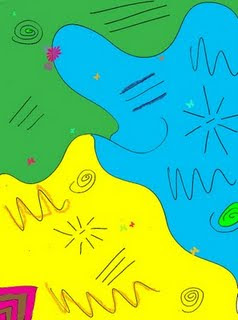The Elements and Principles of Design
Every art has its tools. Just as writers use the elements of language (such as nouns and verbs) as their tools for saying things, artists and designers use the elements of line, color, value, shape, space and texture to express ideas visually. These are the tools graphic designers and illustrators use to create or design a work of art.
To organize the elements of art effectively, artists or designers must follow certain guidelines or procedures in presenting their artwork. These guidelines are called the principles of design.
The elements of design
Line: an art element that may be two-dimensional (pencil on paper) or three-dimensional (wire or rope). The path made by a moving point.
Shape: an art element described as two-dimensional and enclosing an area. Shape can be divided into two basic classes - geometric (rectangle, circle, triangle) and organic (irregular in outline)
Form: an art element, similar to shape, which encloses an area, but is three-dimensional (cube, sphere, pyramid, cylinder) and encloses volume.
Space: an art element that indicates areas in a drawing (positive and negative) and/or the feeling of depth in a two-dimensional work of art.
Positive space-the objects depicted in a work of art, as opposed to the background or area around the objects.
Negative space-the area around the objects in artwork, often called the background.
Texture: an art element that refers to the surface quality as being rough, smooth, soft, etc. It can be actual or implied.
Value: an art element that refers to the lightness or darkness of a color or shade.
Color: an art element that indicates natural and manufactured objects as being red, yellow, green or any other name thatidentifies their hues. Hue is another name for color.
The principles of design
Balance: a principle of design that refers to the equalization of elements in a work of art. There are three types of balance
Asymmetrical-balance in which one side of the composition appears different from the other side while remaining balanced with it.
Symmetrical- balance in which both sides are identical.
Radial-balance based on a circle, with features radiating from a central point.
Contrast: a principle of design that refers to differences in values, colors, textures, and other elements in artwork to achieve emphasis and interest.
Emphasis: a principle of design by which the artist or designer may use opposing sizes or shapes, contrasting colors, or other means to place greater attention on certain areas or objects in a work of art. Emphasis is achieved by dominance and subordination, bright against dull, light on dark, large among small, etc.
Movement: a principle of design that refers to the arrangement of parts in artwork to create a flow of the viewer’s eye through the repeated arrangement of line, shape, color, texture or value; through the orderly positioning of objects; through contrasting positive and negative shapes; through contrasting sizes; or through gradation of colors and values.
Pattern: a principle of design in which combinations of lines, colors, and shapes are repeated. These repetitions create rhythm in a work of art.
Unity: a principle of design that refers to a sense of wholeness or oneness in an artwork. In other words, all the parts look like they belong together. Unity involves the co-ordination of all these parts to communicate the idea of the artwork.
No one element in a design is an entity in itself. Each element is positioned and organized to contribute to the harmony and unity of the total design.
Unity requires varying emphases so that the design has dominant and subordinate parts.
Unity may be achieved by repetition of color, texture, value, shape, and/or line; by similarity-the colors, shapes or textures all resemble each other; and by grouping or overlapping visual elements.

![[sample+upload.jpg]](https://blogger.googleusercontent.com/img/b/R29vZ2xl/AVvXsEjOplnBUMKwYnR4zDk_ZRw1Fqk0lHExk2TmnQyRbHt3TMlVUBmFwqk1MefuQZuZ9j9LgVTUKFzhsTjIcgUGrXxpSp0g1DdiTxGqtaoC2EIrs0b7aurH1HMxRBUiDQZyAyVZmitEOD_41ag/s1600/sample+upload.jpg)
